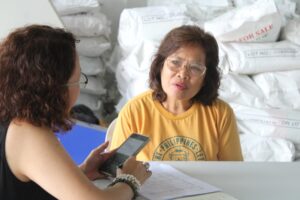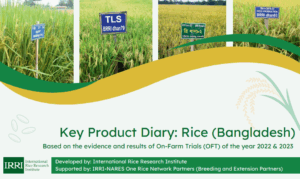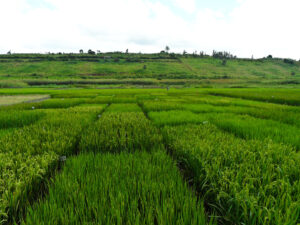The ability to quantify GHG emissions along the entire value chain from farm to shelf for a specific product is the key to enhancing the transparency of the origin of emissions and for reducing emissions. This is especially the case for emissions that are incurred once the paddy rice leaves the farm and enters the phase of processing where emissions from food product losses are often not accounted for and the methods that do exist for quantification are complex and out of reach for non-experts.
The agricultural sector accounts for a sizable contribution of the global greenhouse gas (GHG) emissions and thus, to anthropogenic climate change. According to a recent estimate, the food system is responsible for approximately 26% of the total global GHG emissions. Given the growing demand for food, sustainable development pathways to attaining global food security will rely on both dietary changes and agricultural intensification pathways that stabilize or even reduce GHG emissions.
There is ample evidence that improved practices and technologies can markedly reduce GHG emissions along the food value chain and thus, carbon footprints (CF) of food commodities—for which rice is a good example. Rice is the staple food for more than half of the population on the planet and although rice contributes only 6–8% of the total food systems emissions, the potential for mitigation is high (30–65%) relative to other crops and livestock.
Over recent decades, several methods have been developed for quantifying GHG emissions from agricultural sources. As a widely applied approach, the Intergovernmental Panel on Climate Change (IPCC) guidelines facilitate the quantification of GHG estimates at the national or subnational scale. In the case of rice production, an emission factor—either adopted as a sub-continental default value (Tier 1) or from one’s own empirical field measurements (Tier 2)—is multiplied to the respective rice area and management type (activity data). Irrespective of the IPCC tier the results are given as the amount of CO2 equivalents per area and year in line with the reporting requirements for national communications to the United Nations Framework Convention on Climate Change (UNFCCC).
The concept of carbon footprints, however, assesses GHG emissions as a function of the quantity of rice, e.g., kg CO2e/kgProd—in contrast to kg CO2e/ha/year as required by the UNFCCC. Despite a clear definition in the ISO standard 14067, the term “carbon footprint” is used with diverging connotations in the published literature on rice production.
Low GHG emissions are generally considered as an integral part of sustainable food production. The first globally accepted standard for sustainably produced rice, established by the Sustainable Rice Platform, encompasses 12 performance indicators, of which one is low GHG emissions. Farmers can achieve compliance with this criterion through the application of the recommended water-saving practices and organic/inorganic amendments—but an explicit calculation of the product-specific CF is not required under the SRP certification process.
The ability to quantify GHG emissions along the entire value chain from farm to shelf for a specific product is the key to enhancing the transparency of the origin of emissions and for reducing emissions. This is especially the case for emissions that are incurred once the paddy rice leaves the farm and enters the phase of processing where emissions from food product losses are often not accounted for and the methods that do exist for quantification are complex and out of reach for non-experts.
The specific objectives of our study are:
- Providing a user-friendly and easily accessible tool for CF calculation tailored for the rice value chain including a value-adjusted accounting of by-products,
- Assessing typical baseline of CFs for rice products in the regional context of Southeast Asia,
- Quantifying the contribution of (i) individual stages of the value chain as well as (ii) emissions of different GHG , namely, CH4, N2O and CO2, to the overall CF of the rice product, and
- Providing a comparative scenario assessment of technological options in rice value chains to show the range of CFs of rice products.
The distinctive features of CF-Rice as compared to generic LCA tools are as follows:
In its current version, CF-Rice exclusively deals with the value chain of rice products which obviously limits the potential user group compared to those with specific interest in this commodity. At the same time, however, this focus on one of the most important cropping systems with high mitigation potential still targets a sizable number of potential users who will be encouraged by an easy selection of data inputs and free access to the tool.
Given the focus on rice, we have systematically searched the literature and other open access sources to compile a comprehensive library of available CF data on the different technologies deployed in rice value chains. This technology library is embedded in the tool and encompasses empirical evidence on multiple processing options for harvest and postharvest actions that has recently been published and, thus, constitutes an update on the currently available database on rice.
CF-Rice allows a detailed consideration of stage-specific recovery rates. In turn, the important role of yield losses for determining CFs can be assessed in much more detail.
The CF-Rice database can be expanded by the user by adding adjusted GHG data and recovery rates from new literature sources or their own measurements. This capability broadens the versatility of using CF-Rice within any given geographical context as well as a being a tool for decision-making support, e.g., on identifying suitable investments to reduce CFs.
The impact of different technologies on CFs is shown in our scenario analysis. In order to produce low-carbon rice, special emphasis has to be given to (i) water-saving techniques and (ii) advanced technologies that reduce food losses. The beneficial effect of water-saving has previously been shown for field emissions, but our study set this into the perspective of the overall emissions from the entire value chain and thus, a 27.4% reduction of the CF of the rice product.
Considering further improvements in post-harvest technologies, we arrived at a benchmark of 37.3% reduction for low-carbon rice. It should be noted though that this effect is derived from currently available technologies that are in principle ready for upscaling (e.g., bubble drier, integrated milling facilities, etc.). As for the future, the mitigation effect could further be enhanced if more advanced technologies such as straw baling as well as laser levelling of the soil surface are mainstreamed into the development of rice farming systems.
In terms of the different straw management options, soil incorporation is obviously a preferred practice over field burning due to air pollution and human health factors, but incorporation comes with the caveat of high CH4 emissions in the ensuing cropping season. To some extent, these incremental emissions can be reduced by the mulching of straw and water-saving techniques, but nevertheless this will not lead to a reduction in CFs as compared to the baseline. In turn, the best management option is straw removal from the field which is only economically viable using mechanized baling which is not yet practiced in Southeast Asia.
The computed baseline by CF-Rice represents a moderately high value as compared to the entirety of those published CF values that are based on comparable methodologies. In this study, the CF values ranged by a factor of 2 from the lowest to highest scenario which is less than the range reflected in the literature data. However, this result must be viewed against the backdrop that all scenarios considered had an identical yield level.
In turn, the actual variations of CFs will be more pronounced due to the inherent differences in agronomic performances of rice production across different scales. In Southeast Asia, even the national rice yield averages range from <4 t/ha (Timor Leste, Cambodia, and Myanmar) to >5 t/ha (Indonesia and Vietnam). Although not part of our study, it might also be interesting in this context that the published CFs of other cereals, namely, maize and wheat, are less than half of the CFs calculated for rice.
This relatively high background level makes rice products an especially promising target for future technology advances and investments to reduce food-related GHG emissions.
Read the study:
Wassmann R, Van-Hung N, Yen BT, Gummert M, Nelson KM, Gheewala SH, Sander BO. Carbon Footprint Calculator Customized for Rice Products: Concept and Characterization of Rice Value Chains in Southeast Asia. (2022) Sustainability: 14(1):315.






